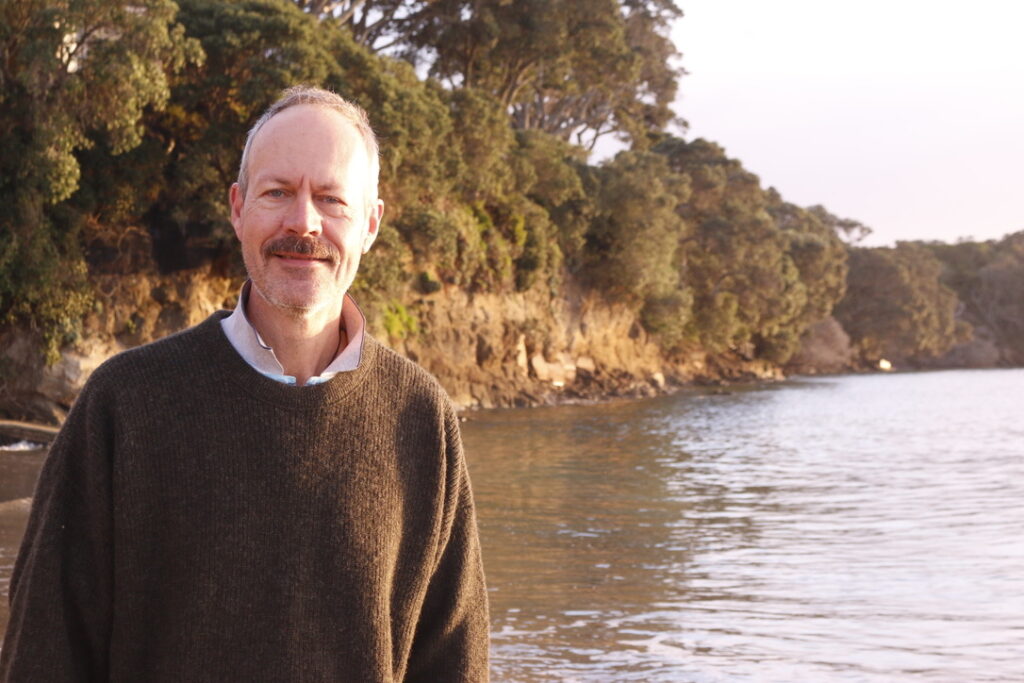What's New
19 June, 2020
Simon Sheen: Island’s lure inspires passion for restoration

Simon Sheen wrangles the teams of volunteers helping return native bush and birds to Motuihe in the Hauraki Gulf. He tells Helen Vause that there’s jobs for all types – and no such thing as a bad day on the island.
In those long lockdown weeks, Simon Sheen’s thoughts often turned to ‘his’ island, just waiting out there in the sparkling Hauraki Gulf.
As the man who’s spent years bringing together the helping hands that are restoring and replanting Motuihe, he wondered what happened when the work schedule stopped and the weeds were left to themselves.
The island turned out to be in pretty good shape after weeks without the usual attention, says Sheen. The weeds were certainly flourishing, but as Sheen sailed out with the first of the returning volunteer crews on a recent perfect Sunday morning, the group felt charmed by a pod of orca encountered on their way to picking up where the good work had left off.
Twenty years ago, Sheen couldn’t have guessed that Motuihe Island and its restoration would become a passion and huge personal commitment alongside a busy career in finance.
But something about the sound of life in New Zealand pushed this Englishman to look beyond life in a quiet part of Kent. So he and wife Kate sold up and moved here with their two small boys, Charlie and Harry, to explore a life in a new country.
“We loved it,” says Sheen, “We didn’t want to have a foot in both countries, so there we were with two kids and no jobs but our leap of faith has worked out very well.”
Never keen on noise and cars, Sheen who rides a bike, says the Narrow Neck neighbourhood offers the perfect lifestyle while giving easy access to work in the city. As well as to the Hauraki Gulf islands.
“I look back on arriving here with a young family and no job. I went up and down Queen St with my CV knocking on doors.”
Sheen landed a job at BNZ bank, where these days he has international trade under his wing.
And soon after, it was the bank’s family Christmas outing in 2003 that landed him on Motuihe Island. Sheen was enchanted.
“To me it was just the most marvellous place.”
Thanks to the bank, he found his way back to Motuihe a couple of years later on a volunteer tree-planting trip organised by his department.
“I was hooked. It’s just a paradise with everything you could possibly want, plus the chance to get involved in something really worth doing. Surely everyone would want to come, I thought.”
It’s a thought he’s often chuckled over as he’s doggedly pursued would-be volunteers over the years since.
The restoration of the island began in 2000, with the formation of a partnership between the Motuihe Island Restoration Trust and the Department of Conservation.
The island was infested with rats, rabbits and invasive pest plants. Only around 20 per cent was then still in bush and the target was set to bring the island back to more like 80 per cent bush cover, through the efforts of volunteers.
Planting started in 2003, and by 2005 the island had been declared pest-free.
It became apparent that finding volunteers and getting them organised to help effectively would be a vital role for the success of the project. And who better to ask than a busy man with kids and a full-on job in the city?
“I leapt into the job without much idea of what I was in for,” laughs Sheen.
At last count there had been 440,000 plants established from seed sourced on the island, propagated in the nursery there and planted out on former pasture. The swelling bird population now includes kiwi, kakariki, saddleback, tui and whiteheads.
The next steps for the forest will include bringing in the larger canopy trees.
“It’s now 20 years in and about 20 years to go, at a guess,” says Sheen.
“The volunteers have been absolutely critical to this project. It’s just amazing to be able to say that every seed collected, every plant raised from that and every plant established has all happened at the hands of volunteers. That and the endless weeding and so much more.
“It has been a pretty stunning result and I do just love the fact that the community has done all this.”
Over the years, teams of volunteers have gone to the island on Wednesdays and Sundays, with 35 to 40 trips annually, taking from six to 60 people, totalling at least a thousand people each year.
When Sheen sat down at nights and weekends to push recruitment of volunteers and coordinate their island work days, he found it was no small task. People were keen for sure, but getting them there, together, on the right day has Sheen tied to computer and phone at home, putting those countless successful working parties together. As the task has grown, Sheen has been able to pull back in his bank job to working a nine-day fortnight, giving him a regular extra day to devote to keeping those helping hands coming.
Is it a bit like herding cats? “Ah, yeah, sometimes,” laughs the diplomatic Sheen. “I’ve learned a lot and I suppose being patient is part of it.”
While some make the trip regularly for a day’s work on the island, many come in large annual corporate groups, from a network developed by Sheen.
“People are keen but I find they’re a lot more likely to actually come in an organised group that might be a firm’s volunteer day.”
On the island there’s something for everyone to help with, from the more strenuous planting and weeding work to helping with nursery work like potting up plants.
“Quite simply, all of humanity can turn up and we cater for all types. Some work like trojans, some find the lure of a swim on a hot day too tempting and some are utterly knackered just by the time they’ve walked up to the planting area. I’ve found the young lawyers are the keenest and the fittest.”
“Every trip over there is different. Everyone’s experience of their day on the island is different.”
Canvassing abilities is a big part of Sheen’s role, as is getting the right people to do suitable tasks. “Every trip over there is different. Everyone’s experience of their day on the island is different. But by the time the boat is passing Brown’s Island on the way over, I’ve mixed and mingled enough to know pretty much how the day will go with the group we’ve got.”
Tales of days on the island mostly stay on the island, but the tactful Sheen shares a few stories.
Like the one about the woman who turned up in high heels. Or the day a couple of lawyers managed to get left behind, despite very clear messages on the departure time.
“We’d already left when a couple of blokes were seen running down the hill waving frantically. They managed to get a boatie to come after us and we picked them up at Islington Bay.”
These days, it’s a bit harder to get volunteers onto the island. With the wharf recently closing temporarily, the trip now usually includes hopping out of a tender onto the beach.
“In a way, trying to get volunteers is a bit like being in the entertainment business, because we are competing with so many other attractions and things for people to do with their time. I certainly still have to work on learning more about what works best for people, what would motivate them and how to keep making it attractive to come.”
He knows a lot of valuable feedback probably walks off the boats at the end of a day, but that’s data he doesn’t have the resource to gather.
“Education is a huge part of what we’re doing, and I’m happy if they go away with more knowledge of what we’re doing and the realisation they can make a difference.
“It’s a wonderful thing to be part of getting such a stunning result on this community project. For me, there’s no such thing as a bad day on that island,” says Sheen, before whizzing away on his bike to the ferry and his day job in the city.

Please consider supporting The Devonport Flagstaff by clicking here:
